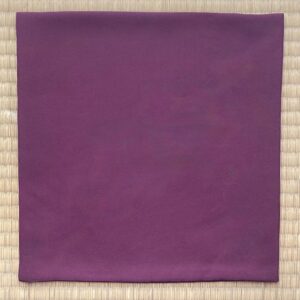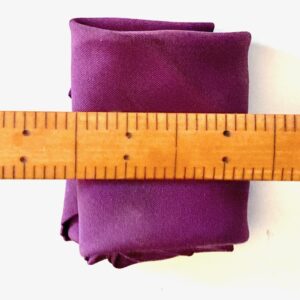Eight-Ten: Fukusa


Fuku-sa, 帛紗, cloth-gauze, purple silk; 9 x 9.5 sun kane-jaku or 7.2 x 7.6 sun kujira-jaku.
The fuku-sa, 帛紗, cloth-gauze, is a square of silk fabric that is used by the host, tei-shu, 亭主, house-master, to purify utensils. The piece is made of a rectangle 1 x 2 kane-shaku, that is folded in half and hemmed on three sides. When not being used, the fukusa is folded in half diagonally twice, and tucked under the obi, 帯, sash, to the side.
Before purifying certain Tea utensils, the fukusa is examined and folded, which is called fukusa sabaki. There is an issue with the word sabaki, as there are two words that are both used when handling the fukusa; 裁 and 捌.
The fukusa is held in both hands to form a square which is turned clockwise, temporarily folding each edge in half to approximate two edges. This is enacted on each of the four edges to create ‘eight’ edges. While folding the fukusa, the handler contemplates various aspects of universal and personal relevance. This procedure is termed sabaki, 裁, judge, decide, etc.
After the examination of the four sides, the fukusa is folded five times to form a small square to purify the utensil, and this procedure is called sabaki, 捌, handle, arrange. This Kanji is also used for the Japanese number eight, hachi, 八, especially in official documents for clarity.

Collectively, the handling of the fukusa, using the word sabaki, refers to the manipulation of the fukusa; 4 times when examining it, and 5 times when folding it. The numbers 4 and 5 are identified with the relationship of 8 to 10.
There are several ways that the fukusa is handled and folded. In a very formal Tea presentation, the fukusa is folded into rectangles and ‘squares’ called shin–sabaki, 新捌き, true-folding. In a somewhat less formal manner that might be deemed semi-formal, the fukusa is first folded in half diagonally, and then ‘squarely’, which may be called gyō-sabaki, 行捌き, transitional-folding. In each procedure, the fukusa is folded five times.

The fukusa is folded in half to form a triangle, making a diagonal measurement of 13.08 sun kane-jaku. It is then folded in half five times creating a width of 1.635 sun kane-jaku. Because of the nature of the thickness of the fabric, which varies, it is possible that measurement of 1.635 sun kane-jaku becomes 1.8 sun kane-jaku, as it appears in the photograph.
When folded in half diagonally, the fabric is on the bias so that it can be stretched somewhat. The 5-fold fukusa rectangle measures 1.635 x 1.8 sun kane-jaku. The thickness of the folded fabric varies, but when taken into consideration, the intended dimension may have been 1.6 sun kane-jaku. When 1.6 is compared with 1.8, the ratio is 10 to 8.888 to infinity. This is a number that has tremendous symbolic significance. The fukusa, metaphorically, purifies certain utensils with Infinity in Time and Space.
The fukusa is examined on four sides, yo-hō sabaki, 四方捌き, four-direction examine. When handling the fukusa purifying certain utensils, the fukusa is examined on four sides, although when turning the fukusa the first and last edges are not examined but pass through the hands. This action may be expressed as “ro-ppō sabaki”, 六方捌き, six-direction examine, but only four consecutive edges are examined.
Although it is not an aspect of the traditions of Urasenke, which I have been studying since 1972, I think of concepts in Chanoyu other than simply counting one, two, three, four, when examining the fukusa, and the same when folding the fukusa. I have in mind Rikyū’s four precepts of Chanoyu: Wa Kei Sei Jaku (和敬清寂) when examining, and when folding the fukusa having in mind the Go-gyō, 五行, Five-transitions, the five physical elements: Moku, 木, Wood, Ka, 火, Fire, Do, 土, Earth, Gon, 金, Metal, Sui, 水, water.
For further study, see also: Kobukusa and Chakin and Lotus

